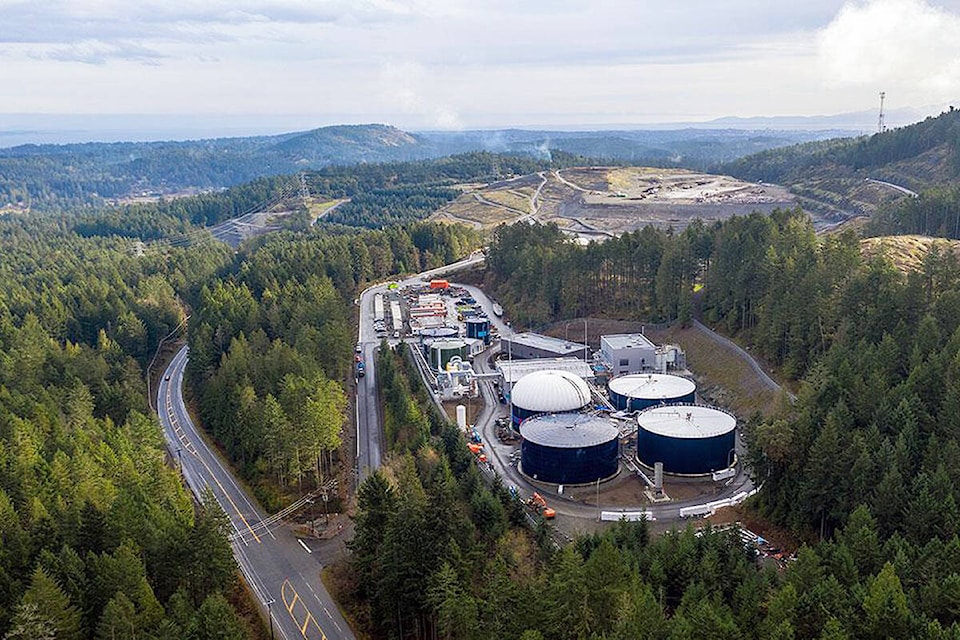A Greater Victoria group concerned about the possible environmental impacts of land-applied biosolids is taking a stand, after the Capital Regional District dumped nearly 6,000 more tonnes of the waste than planned at the Hartland Landfill in 2021.
The Peninsula Biosolids Coalition is calling on the CRD to immediately stop the spread of biosolids at the landfill and pursue a different disposal method for the region’s residual waste.
At present, Greater Victoria’s sewage is meant to be processed into Class A biosolids – small, dry pellets that meet provincial safety standards – and shipped to the Lafarge cement plant in Richmond to be burned as fuel. The CRD has allowed for 700 tonnes of the solids to be deposited at the Hartland Landfill each year, to account for the plant’s annual maintenance.
But in 2021, the regional sewage treatment system’s first operating year, nearly 10 times that amount (6,630 tonnes) were landfilled, the majority of which didn’t meet Class A standards. Only 631 tonnes made their way to Lafarge.
READ ALSO: CRD dumps 6,100 tonnes of treated sewage at landfill – not the expected 700 – so far in 2021
The CRD says some issues are to be expected as the equipment gets up and running and that the landfilled biosolids are safe within the leachate containment zone, but the coalition isn’t convinced.
The group is concerned about heavy metals, pharmaceuticals and other chemicals that are present in biosolids. If any of the substances did escape the landfill into the surrounding watershed or park, the impacts could be devastating, the coalition says.
“… this practice puts at risk those who use nearby recreational areas, live and farm nearby, and operate businesses dependent on uncontaminated water,” Dave Cowen, CEO of The Butchart Gardens and coalition member, said in a statement.
The group is asking the CRD to, at a minimum, have an independent third party test the surrounding area for any contaminants once a month.
CRD senior manager of environmental protection, Glenn Harris, told Black Press Media he doesn’t believe third-party testing is necessary. Not only is an extensive monitoring system in place within the landfill, the CRD conducts some off-site surface water tests, he said.
“We feel pretty confident there’s no off-site migration of any contaminants,” Harris said.
He also pushed back on the coalition’s claim that biosolids are harmful, pointing out that in many parts of the world, they are used as agricultural fertilizer. On their website, the B.C. government says the solids can improve soil conditions and provide nutrition for plants, if produced to provincial quality standards.
READ ALSO: Capital Regional District approves land use for sewage biosolids
Harris said Class A biosolids are being produced at a higher rate so far in 2022, but an out-of-commission transportation truck and unplanned closure at Lafarge have prevented them from getting the material to the cement plant. The CRD doesn’t currently have the storage capacity to hold them while the plant is closed.
However, the cement plant is only the CRD’s short-term plan. On March 23, staff will present a report on possible long-term solutions to the core area liquid waste management committee. One avenue, which the coalition is also in favour of exploring, is thermal treatment such as gasification.
Harris said the plan is to conduct public consultation on the resulting options by the end of 2023. The CRD has until mid-2024 to get a long-term plan to the province.
READ ALSO: Rural Saanich residents aim to flush biosolids plant
Do you have a story tip? Email: jane.skrypnek@blackpress.ca.
Follow us on Twitter and Instagram, and like us on Facebook.
